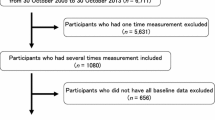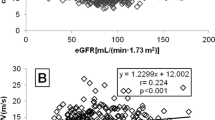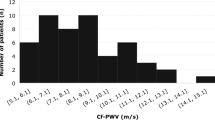Abstract
Microalbuminuria is associated with higher cardiovascular mortality, especially in diabetics. But the direct association between microalbuminuria and vascular wall properties is still not clear. We investigated quantitative carotid stiffness (QCS) index in relation to microalbuminuria in 260 Chinese diabetic patients. In categorical analyses, patients with elevated urinary albumin-to-creatinine ratio (uACR) had higher QCS than those with normal uACR (P < 0.001). The corresponding values for QCS values were 4.4 and 5.9, respectively. In multiple stepwise regression analyses, QCS was significantly associated with age, uACR, plasma glycosylated hemoglobin A1C (HbA1C), and current smoking (P < 0.05 for all). In conclusion, carotid stiffness as measured by QCS, a local functional measurement of the arterial wall, is increased in type 2 diabetes with microalbuminuria.

Similar content being viewed by others
References
E. Bonora, S. Kiechl, F. Oberhollenzer, G. Egger, R.C. Bonadonna, M. Muggeo, J. Willeit, Impaired glucose tolerance, Type II diabetes mellitus and carotid atherosclerosis: prospective results from the Bruneck Study. Diabetologia 43, 156–164 (2000)
M. Wohlin, J. Sundström, J. Arnlöv, B. Andrén, B. Zethelius, L. Lind, Impaired insulin sensitivity is an independent predictor of common carotid intima-media thickness in a population sample of elderly men. Atherosclerosis 170, 181–185 (2003)
M. De Michele, S. Panico, E. Celentano, G. Covetti, M. Intrieri, F. Zarrilli, L. Sacchetti, R. Tang, M.G. Bond, P. Rubba, Association of impaired glucose homeostasis with preclinical carotid atherosclerosis in women: impact of the new American Diabetes Association Criteria. Metabolism 51, 52–56 (2002)
J. Stamler, O. Vaccaro, J.D. Neaton, D. Wentworth, Diabetes, other risk factors, and 12-year cardiovascular mortality for men screened in the Multiple Risk Factor Intervention Trial. Diabetes Care 16, 434–444 (1993)
C.E. Mogensen, E.M. Damsgaard, A. Frøland, S. Nielsen, N. de Fine Olivarius, A. Schmitz, Microalbuminuria in non-insulin dependent diabetes. Clin. Nephrol. 38, 528–538 (1992)
G.C. Viberti, R.D. Hill, R.J. Jarrett, A. Argyropoulos, U. Mahmud, H. Keen, Microalbuminuria as a predictor of clinical nephropathy in insulin-dependent diabetes mellitus. Lancet 1, 1430–1432 (1982)
E.R. Mathiesen, B. Rønn, B. Storm, H. Foght, T. Deckert, The natural course of microalbuminuria in insulin-dependent diabetes: a 10-year prospective study. Diabet. Med. 12, 482–487 (1995)
R. Sukhija, W.S. Aronow, P. Kakar, L. Garza, R. Sachdeva, A. Sinha, J.L. Mehta, Relation of microalbuminuria and coronary artery disease in patients with and without diabetes mellitus. Am. J. Cardiol. 98, 279–281 (2006)
G. Viberti, Etiology and prognostic significance of albuminuria in diabetes. Diabetes Care 11(10), 840–845 (1998)
M.L. Bots, A.W. Hoes, P.J. Koudstaal, A. Hofman, D.E. Grobbee, Common carotid intima-media thickness and risk of stroke and myocardial infarction: the Rotterdam Study. Circulation 96, 1432–1437 (1997)
C.D. Stehouwer, M.A. Gall, J.W. Twisk, E. Knudsen, J.J. Emeis, H.H. Parving, Increased urinary albumin excretion, endothelial dysfunction, and chronic low-grade inflammation in type 2 diabetes. Progressive, interrelated, and independently associated with risk of death. Diabetes 51, 1157–1165 (2002)
T. Jensen, J. Bjerre-Knudsen, B. Feldt-Rasmussen, T. Deckert, Features of endothelial dysfunction in early diabetic nephropathy. Lancet 1, 461–463 (1989)
T. Deckert, B. Feldt-Rasmussen, K. Borch-Johnsen, T. Jensen, A. Kofoed-Enevoldsen, Albuminuria reflects widespread vascular damage: the Steno hypothesis. Diabetologia 32, 219–226 (1989)
T. Deckert, T. Jensen, B. Feldt-Rasmussen, A. Kofoed-Enevoldeen, K. Borch-Johnsen, S. Stender, Albuminuria a risk marker of atherosclerosis in insulin dependent diabetes mellitus. Cardiovasc. Risk Factors 1, 347–360 (1991)
H. Yokoyama, T. Aoki, M. Imahori, M. Kuramitsu, Subclinical atherosclerosis is increased in type 2 diabetic patients with microalbuminuria evaluated by intima-media thickness and pulse wave velocity. Kidney Int. 66, 448–454 (2004)
A. Smith, J. Karalliedde, L. De Angelis, D. Goldsmith, G. Viberti, Aortic pulse wave velocity and albuminuria in patients with type 2 diabetes. J. Am. Soc. Nephrol. 16, 1069–1075 (2005)
C.D. Stehouwer, R.M. Henry, J.M. Dekker, G. Nijpels, R.J. Heine, L.M. Bouter, Microalbuminuria is associated with impaired brachial artery, flow-mediated vasodilation in elderly individuals without and with diabetes: further evidence for a link between microalbuminuria and endothelial dysfunction—The Hoorn Study. Kidney Int. 66, S42–S44 (2004)
K. Aso, M. Miyata, T. Kubo, H. Hashiguchi, M. Fukudome, E. Fukushige, N. Koriyama, M. Nakazaki, S. Minagoe, C. Tei, Brachial-ankle pulse wave velocity is useful for evaluation of complications in type 2 diabetic patients. Hypertens. Res. 26, 807–813 (2003)
Y.P. Liu, W.W. Zhan, Y.F. Zhang, Y.H. Chen, Y.Y. Lin, Y. Zhu, X.P. Ren, X.Y. Li, G. Ning, Carotid intima-media thickness and stiffness in relation to type 2 diabetes in Chinese. Endocrine 31, 289–293 (2007)
M. Furtner, S. Kiechl, A. Mair, K. Seppi, S. Weger, F. Oberhollenzer, W. Poewe, J. Willeit, Urinary albumin excretion is independently associated with carotid and femoral artery atherosclerosis in the general population. Eur. Heart J. 26, 279–287 (2005)
J.M. Forbes, M.E. Cooper, M.D. Oldfield, M.C. Thomas, Role of advanced glycation end products in diabetic nephropathy. J. Am. Soc. Nephrol. 14, S254–S258 (2003)
W.T. Friedewald, R.I. Levy, D.S. Fredrickson, Estimation of the concentration of low density lipoprotein cholesterol in plasma without use of the preparative ultracentrifuge. Clin. Chem. 18, 499–502 (1972)
Acknowledgments
Clinical and laboratory results of the study participants were provided by Shanghai Clinical Center for Endocrine and Metabolic Diseases. The present study would not have been possible without the participation of the patients. We are sincerely indebted to Dr. Wang Jiguang for revision of the manuscript.
Author information
Authors and Affiliations
Corresponding author
Additional information
Wei-Wei Zhan and Yu-Hong Chen have contributed equally to this article.
Rights and permissions
About this article
Cite this article
Zhan, WW., Chen, YH., Zhang, YF. et al. Carotid stiffness and microalbuminuria in patients with type 2 diabetes. Endocr 35, 409–413 (2009). https://doi.org/10.1007/s12020-009-9172-4
Received:
Accepted:
Published:
Issue Date:
DOI: https://doi.org/10.1007/s12020-009-9172-4




